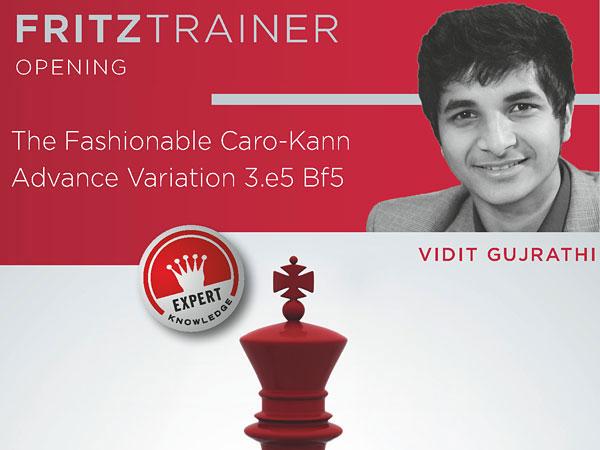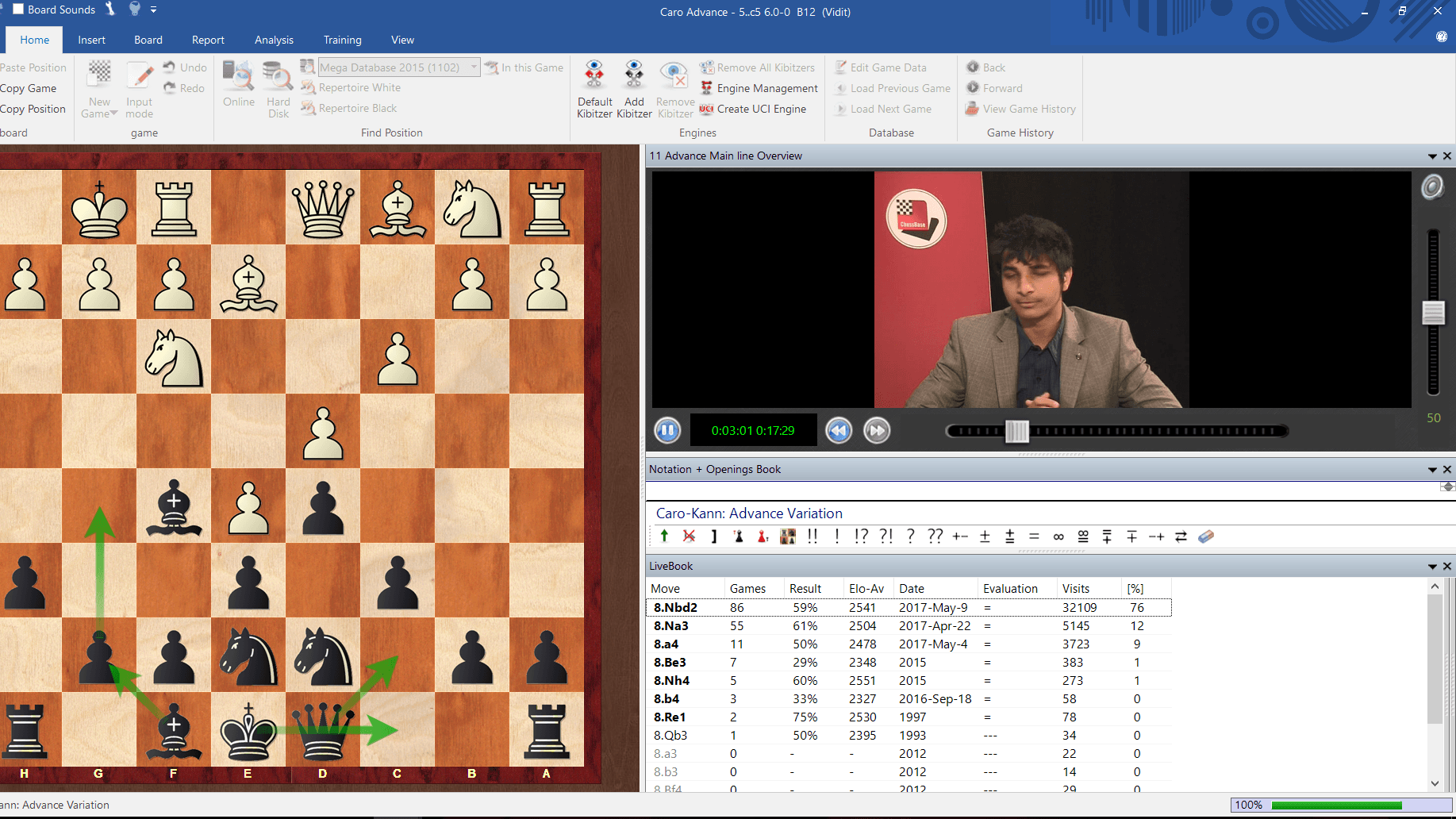
Review - The Fashionable Caro-Kann - Volume 2 by GM G. Vidit, Chessbase 2016
I have to admit that I was a little surprised when I saw that the young and very strong Indian Grandmaster, Gujrathi Vidit filming a set of opening DVDs for Chessbase. After all, he is still an active competitive player and I was more used to names like Bologan, Tiviakov or Muller etc, who are of course very strong players still but are no longer spring chickens in the chess world. Vidit is also not particularly well known in the publication world and hence like many others, I was intrigued and wanted to see what he can add to the, already vast material on the Caro-Kann.

Gujrathi Vidit
Volume 1 covers non-Advanced Variation lines, such as the Classical 3.Nc3/3.Nd2, the Panov Botvinnik, the recently rather trendy Two Knight's variation and the Exchange variation while Volume 2 focuses on the entire 3.e5, or the Advance Variation. The exact content and the way the chapters have been structured can be seen here, so I won't bother copying and pasting the content page here. Given that the Advanced is by and large White's most popular attempt against the Caro-Kann, I thought it would make sense to check the lines in Volume 2 first.
Vidit started the DVD by giving a short introduction about himself, such as the fact that he was 2688(!!) at the time of filming, and that he had played approximately 50 games in the Caro-Kann so he has reasonable experience of the opening. He explained that the Caro-Kann is a complex and strategical opening and studying the opening will invariably help the audience in improving general middlegame understanding. As such, he acknowledged that some of the lines can be very long but throughout the DVDs, you can see that he doesn't go into full detail in the clips as these can be found in the accompanying Chessbase files. Instead, he focused a lot more on strategy instead of these long lines.

Vidit comes across as humble and unassuming in his presentation. Perhaps, because of his relative inexperience in filming an actual DVD in English, he appears to lack a little confidence during his presentation given the rather large number of fillers (the erms and errs) he uses in his sentences and also the fact that he sometimes struggles to find the right word or phrase to express his thoughts. I daresay that this sort of thing invariably always improves with experience and a little bit of training but if you are able to put the presentation style aside and focus entirely on the content, you will soon realise that Vidit has a lot of things to say that are extremely instructive and useful.
When I was searching for a line against the Caro, IM Erik Kislik had tried to sell the merits of the 4.Nd2 variation, citing its relatively simplicity and solidity and after doing a bit of work there, I had concluded that 4..e6 5.Nb3 c5!? is a simple equaliser. Vidit, rather surprisingly broke away from convention and suggested a number of options and explained the themes and styles behind each one of them. For instance, he went through the early stages of the game Naiditsch - Nisipeanu, Dresden 2008 and the possible plans from both sides.

Vidit calls this "the ancient line" and indeed the idea of ...Nd7, ...Ne7-c8 has been around for ages and was recommended by Schandorff for instance, in his GM repertoire book on the Caro-Kann. This appears to be Vidit's preferred set-up and I would actually have liked to see this covered in a bit more detail. Instead, Vidit covered a few other options highlighting their pros and cons and all of these are cramped into a 17 mins clip which means he could hardly have hoped to include too many details in the clip. On the other hand, I still learnt something useful from this, kinda "summarised" clip such as the fact that after 4.Nd2 e6 5.Nb3 c5, the rare 6.Bb5+!?, with the idea of 6..Nc6 7.dc Bxc5 8.a4!? can be quite dangerous for Black.
Vidit does not go into further detail but simply adds that he does not feel entirely comfortable with Black's position and as such is not able to recommend it fully. Black appears to be fine with a little precision, i.e with 8..Qb6 which I wouldn't elaborate here although I can say that White is definitely on the sunny side of equality. Perhaps, this chapter could have been split into 2 chapters with the first one being a summary of options, and the second focusing on Vidit's main suggestions against 4.Nd2. Or perhaps I am asking for too much!
I then went straight for the chapters on the Short Attack which is characterised by the moves 4.Nf3 and 5.Be2. Anyone looking at this for the first time in his life would feel entirely bewildered if he is told that this extremely unassuming set-up is supposed to be the most promising variation against the Caro-Kann. It is impossible to explain why this is so in a few words but watching this DVD, or this particular segment spanning over 5 long-ish clips, would definitely help substantially.

Vidit going through a possible plan against the Short system but ultimately decided to recommend 5..c5!
In the intro to this segment, Vidit once again goes through the alternatives and explains why he doesn't like them before finally settling on 5..c5, the absolute mainline. He first covered 6.0-0, which was initially the preferred move order when the Short system first came into vogue. Played quickly followed 6..Nc6 7.c3 when Black has a choice:
The overwhelming main move from this position is 7..cd4 but Vidit does not like it and explains in considerable detail why that is so. As such, he prefers the waiting move 7..Bg6!?, with the idea 8.Be3 Qb6.
This is one of the many examples where I found Vidit's analysis to be thoroughly impressive. While Vidit did not go through all the sub-lines arising from this position, his Chessbase notes include 7 options for White here, including the rather obscure novelty 9.Na3 which was actually recently played in a game between Jorden van Foreest and Awonder Liang. Vidit's analysis in this line holds up relatively comfortably, He also went through the dubious looking 9.Qb3 and showed an instructive ending played in Capablanca style as a mini-middlegame/endgame lecture.

White has just played 11.Nbd2 although I would argue that developing this knight immediately is not an urgency, and that 11.Nh4 followed by Nxg6 and a3 is a little more accurate. Here, Vidit explained a little about this structure and typical motifs for Black. This sort of structure arises a lot from the London System (See the game Teo Wei Xing - GWM here) and you can do worse than to go through Vidit's brief description of the game. I personally cannot decide whether having the light square bishop out so early benefits Black all that much given that White can swop it off for instance with 11.Nh4 but Vidit makes a convincing case for Black.
The next clip is a massive discussion on the position arising after 6.Be3 cd 7.Nd4 Ne7 8.c4.
This is the old main line and has been reached in nearly 500 games in the online database. Contesting the centre immediately is a logical and principled option but Black's resources have been worked out comfortably in the recent years. Vidit explained that the manoeuvre Nd4-b5 or Na3-b5 is an important strategical/tactical motif and hence after 8..Nbc6 9.Qa4 (the only critical try), it is extremely important to play the move 9..a6! before proceeding with the standard ..dxc4 followed by ..Qa5.
After 10.cd5, Vidit went through the game Svidler - Anand 2002 which is an excellent illustration of the dangers that Black potentially faces in this line:

White, with the bishop pair, an easy plan and a development edge is clearly better. Therefore, Vidit recommends 10..b5! and convincingly demonstrated easy equality there.
Instead of 10.cd5, Vidit moved on to 10.Na3 and after 10..Qa5+ 11.Qa5 Na5 12.0-0 dc 13.Nc4 Nxc4 14.Bc4 Be4! (Vidit explained that it was important to cover the d5 square) 15.Rac1 Bd5 16.Be2 Rc8 17.Rc8 Nc8 18.Rc1 Kd7, we arrived at a rather critical position.

As you can see from the screenshot, the engine suggests that White has a slight edge here but Vidit went through a correspondence game briefly to show that White's advantage is only nominal and that Black eventually equalised and even went on to win the game. This is the kind of position that you need a world-class grandmaster to explain as one can easily be influenced by the engines' evaluation. A famous trainer once told me that chess engines tend to over-value space which is why I suspect that Komodo gave a slight plus for White because of the advanced e5-pawn, much like how the Gruenfeld is supposedly worse in every variation when White has pushed his d-pawn to the d5 square.
Instead, 10.Nc3 is the most critical and after a few natural moves, we quickly arrive at the following position:
White has just played 16.Be2xc4
One of the things I always like to check when it comes to publications focused on the openings is whether recent works have been checked. As such, one of the main resources that I have is Alexey Dreev's excellent book, Attacking the Caro-Kann and it makes sense to do a simple comparison especially when Vidit mentioned in the introduction that Dreev is one of his heroes in the Caro-Kann. I've checked both sets of lines carefully and concluded that Vidit's analysis holds. Here's a truncated version of what you can expect:
I'll now like to focus on the absolute mainline of this variation of the Caro-Kann but before I do that, I'll just like to point out that in the chapter where White goes 8.Nd2 and 9.N2f3, Vidit did not analyse a line that Dreev suggested that seemed, optically at least, to be quite dangerous for Black. Black is fine though, as can be seen from the following simple analysis:
In the mainline with 8.0-0 and 9.Bb5, Vidit once again emphasized that he had played this particular line against Shirov at the 2016 Isle of Man Open and he asked the viewer not to be afraid of long variations but instead to try and understand and embrace them. This 20-min clip is another massive discussion and again I like the fact that Vidit consistently covers model games and novelties even from White's perspective. Here are a few examples that I like:
Vidit explains why development matters more than structure in this particular position and advocates 12..dc4!, with potential ideas of ..Nd5 and ..Bd3. The following position could arise:
This position was reached in Gelfand - Karpov 1995 and here, Vidit suggests the novelty 15..c5! and even though the engine does not initially like it, it soon realises that Black completes development extremely quickly and the evaluation eventually improves to equality after you give it a bit more time.
White has just played 14.Bd4 which is the main choice of the engines. In many ways this is the most critical line for White in the entire Advance variation with 6..c5 complex and here, Vidit covers the move 14..Rb8!, his own TN, with impressive depth. Here's yet another truncated set of analysis from our author:
Excellent stuff indeed!
One thing that puzzled me was the fact that even though the DVD was released in April 2017, I found the following game in the database that was played in December 2016:
I emailed the Chessbase editors and understand that the DVD was filmed in October 2016 which explains why such a momentous win over a giant was not featured in the DVD. While I can understand that editing a film could well take several months, I would have liked to see that at the very least, an update via a Chessbase file be included to run through what has transpired from the date the DVD was filmed to the actual date of publication. In this time and age, 6 months is a rather lengthy period especially for an opening video and I would have thought that it wouldn't have been particularly difficult to do. Incidentally, I was also slightly annoyed with the fact that Chessbase products generally do not publish the date of release or filming which forces consumers to find out the date by other means.
Summary:
Volume 2 of the Fashionable Caro-Kann is easily the most detailed and comprehensive opening DVD I have seen from Chessbase yet. The young Indian superstar explains the most critical aspects of the arising middle-games and often presents model games, important theoretical novelties from both colors and I believe he definitely gave away his fair share of secrets given that he plays these lines himself and even beat a giant like MVL. There were a few omissions here and there when I compare his lines with recent sources but in general the analysis is of extremely high quality that virtually all the critical options are covered. Vidit also gives a very useful and well-thought recap at the end of each clip and I found that it helped me a lot in remembering what just happened as it can be very easy to be lost after all that analysis. What Chessbase really should do is to publish the filming date and provide an update between the filming date and the actual date of release (I suspect they will have to pay the authors a little more) to make the entire work a little more robust.
I feel that this DVD is a must for anyone rated above 1800 who wishes to study the Caro-Kann from both sides. I am not a Grandmaster (yet!) but I can imagine that even GMs will benefit from some of the deep analysis that Vidit has presented. However, I struggle to convince myself that these lines are suitable for players who are below that rating threshold given just how complex and imposing some of the lines are. Perhaps, this group of players should focus sole on the lines presented in the clips and just go through the full analysis in the chessbase files to a degree only when they feel comfortably ready to do so.
Rexter rating:
***** - you will not regret buying this!
